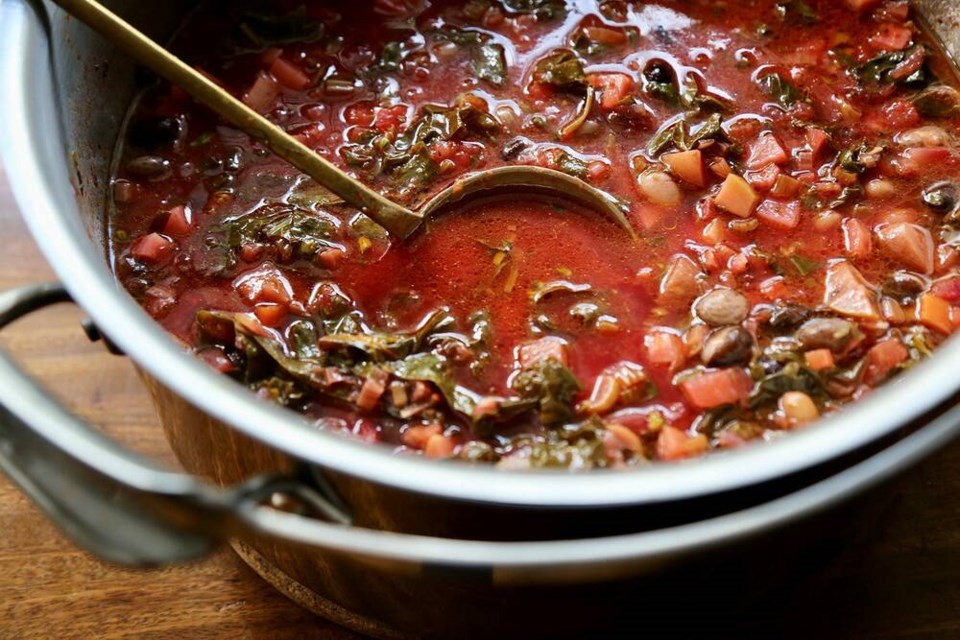Minestrone, Italian for “that (soup) which is served”, is to me the food equivalent of wine. There is no one recipe for minestrone soup. Like wine, minestrone represents the terroir and the season, and of course the maker, or soup master.
Always, minestrone is made from vegetables. Almost certainly tomato, onion, carrot, celery and garlic. And quite possibly chopped leafy greens, herbs, and various root stock. Grated hard cheese or cheese rind-flavoured stock figure prominently.
It seems to me that the starch, be it beans or some form of pasta or grain, is what most immediately identifies minestrone styles by region of origin. In my kitchen library of aged cookbooks, I find recipes for Minestrone alla Genovese that include various forms of small pasta, but always porcini and a dollop of basil pesto.
Minestrone Friuli features barley, and Minestrone Milanese very often includes rice. Blue Zone diets prescribe the daily consumption for lunch, of minestrone with beans and/or chickpeas. Blue Zone expert Dan Buettner made famous a Sardinian version with fava and cranberry beans, plus chickpeas.
In our home, minestrone starts with puréed San Marzano and Amish Paste tomatoes that we process in the fall, the predictable cooked-down sofrito of heirloom onion, carrot, celery and wild garlic – with leek, potato, Swiss chard, soft Siberian kale, copious minced rosemary, thyme and oregano, and most definitely handfuls of chopped leafy herbs.
Summer minestrone presents more vegetal and fresh, and is lovely served chilled, gazpacho style. As the weather turns cold and root vegetables sweeten, our minestrone takes on the chunky warmth that our bodies seem to need. All this of course, is dictated by our garden and the soil biology that feeds our produce and in turn our bodies.
Our youngest daughter and I made minestrone this week. A single large pot which progressed from a modest starch-free summer version, tinged magenta by the betalain of a single small beet, to a more substantial whole-meal incarnation served over a bed of braised rainbow chard, and then finally to that familiar rustic mama soup into which I cram every phytonutrient and accessory goodness that I can find in the garden and pantry.
The latter, thick and chunky minestrone benefited medicinally by the addition of a hefty scoop of unfiltered, collagen-rich, highly concentrated bison bone broth, or fond, which had been hard-boiled for the better part of two days and then frozen in 125-millilitre glass jars.
Four types of heirloom bush beans, this year Canadian Wild Goose, Provider, Purple Teepee, and Mont D’or added texture, colour and considerable plant protein. I had intended to include the chickpeas of Spello that I grew for the first time this season, but come soup-making the tiny peas were still encased in dried pods, in a bowl in the pantry.
Spello, a town and region in Umbria, Italy, is famous for chickpeas. And, as evidenced by the meagre quantity and size of my chickpeas, Spello is better suited than my garden, to growing pulses. I will grow chickpea again though, for its beautiful growth habit and nitrogen-fixing.
Minestrone’s finest quality is the ease and freedom with which it comes together. In this age of food-channel recipe fatigue, frankenfood fright, and supreme lack of time to get healthy and delicious food on the table, minestrone promises relief.
Make plenty of minestrone with whatever comes to mind, in the style that makes you happy. Freeze or pressure-can surplus, if you have time and space. Adding beans and starch last preserves form and texture, but if you don’t, the soup will still be delicious.
Laura Marie Neubert is a West Vancouver-based urban permaculture designer. Follow her on Instagram @upfrontandbeautiful, learn more about permaculture by visiting her Upfront & Beautiful website or email your questions to her here.
For a taste of permaculture, watch the video below:



